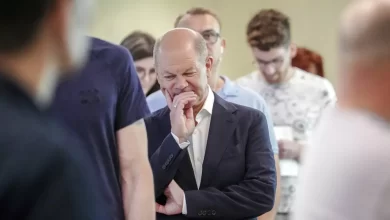Tourists caught in middle of strike battle between French workers and government.
 Peering through the glass into the darkened hall of the Pompidou Centre, Linda Lawson and her son, Daniel, didn’t like what they saw. Instead of the bustle they had expected from Europe’s largest modern art collection, they were greeted with silence, switched-off lights and letters running diagonally across the window that spelled out G-R-E-V-E.
Peering through the glass into the darkened hall of the Pompidou Centre, Linda Lawson and her son, Daniel, didn’t like what they saw. Instead of the bustle they had expected from Europe’s largest modern art collection, they were greeted with silence, switched-off lights and letters running diagonally across the window that spelled out G-R-E-V-E.
“This is the first museum we’ve come to and it’s shut,” said Lawson, in Paris on an extended summer holiday from Brisbane, Australia. “It’s such a wonderful collection and I wanted Daniel to see it. But I’ve lived in France before and I know it’s a part of life.” Her 16-year-old travelling companion, however, was rather less accepting. “I’m really pissed off,” he admitted, turning to look again through the window. A pop-art picture of former president Georges Pompidou stared sternly down at him; the centre was, read the poster, “on strike”.
It may be the most visited city in the world, with a justified reputation for its cultural gems, but this week Paris was no place to be an art lover or a tourist. Furious at plans by French president Nicolas Sarkozy to cut jobs in state-run institutions, the staff at many of the capital’s leading venues stayed at home and left tourists out in the cold.
Yesterday six of the country’s national museums were shut, along with a host of other sites including the Arc de Triomphe, the Gothic chapel Sainte Chapelle and the towers of Notre Dame. When told that her other gallery of choice, the Musée d’Orsay, was also closed to the public, Lawson could not hide her disappointment – or her frustration. “Well, that’s it then,” she said. “Everything we want to see is shut.”
For many tourists, the sense of dejection was particularly acute because Paris, arguably more than any other European city, touts its virtues as a holiday destination on the basis of its magnificent museums.
 Donald Trump says Zelensky ‘come back when he is ready for Peace’
Donald Trump says Zelensky ‘come back when he is ready for Peace’ German elections and why this vote is important
German elections and why this vote is important Turkey Arrests Three Opposition Journalists
Turkey Arrests Three Opposition Journalists The Royal Mile is becoming increasingly dangerous
The Royal Mile is becoming increasingly dangerous